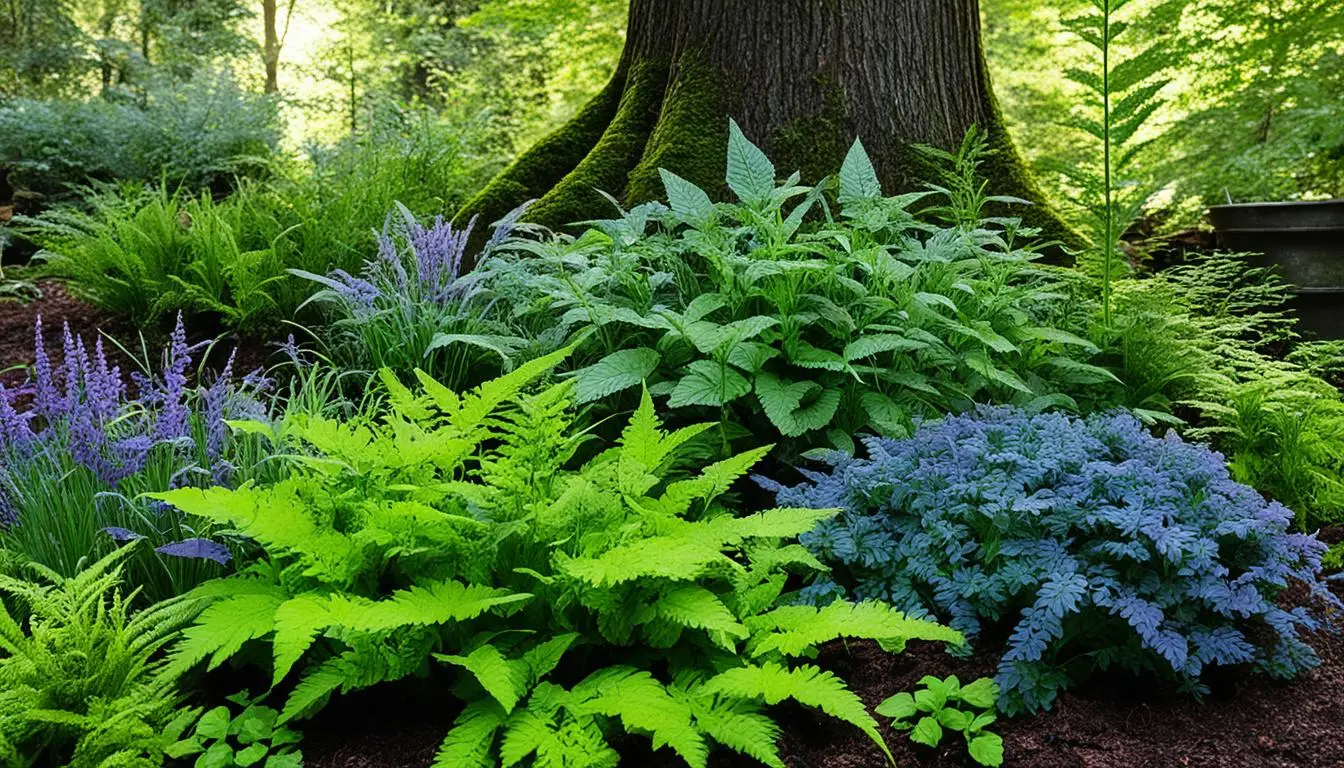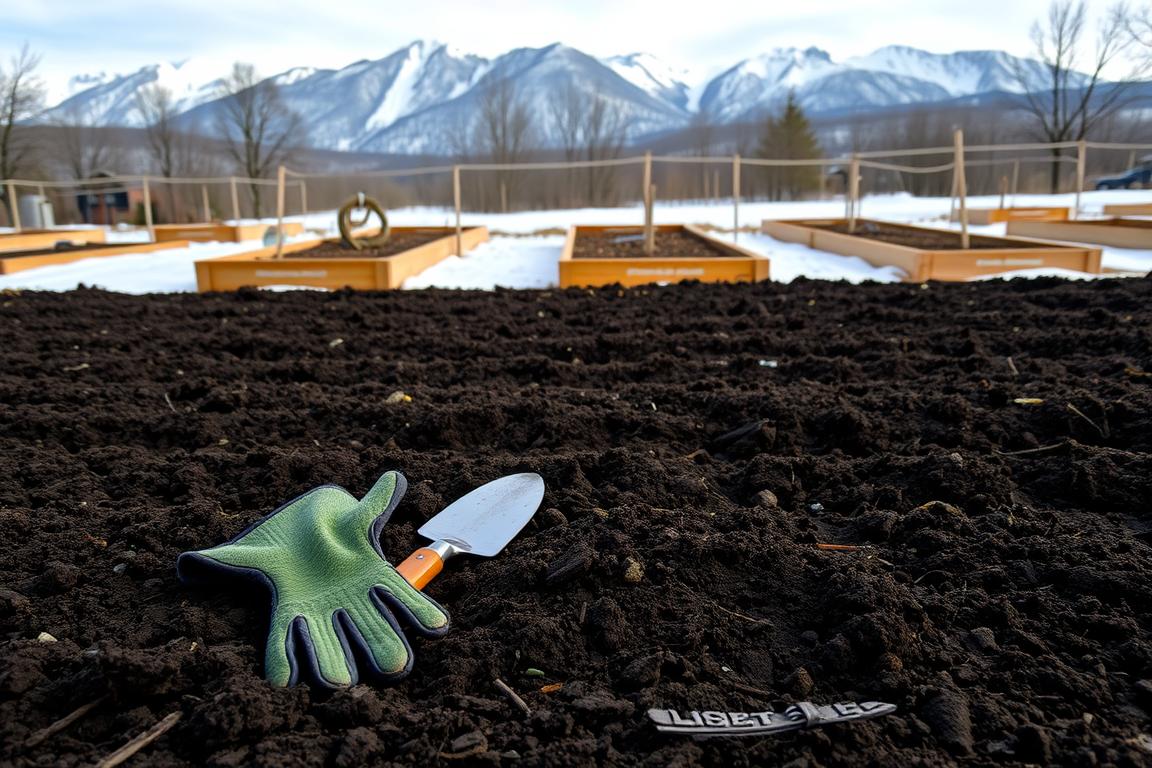Are you finding it hard to grow herbs in shaded areas? Don’t worry. There are many herbs that love low light. They will do well in your indoor, container, or backyard herb gardens. These herbs bring great flavors and smells to your cooking.
This guide looks at herbs perfect for shady spots. It shows you which herbs do best in less light. You’ll learn about herbs like chervil and lemon balm. With this knowledge, your herb garden will flourish, even in the shadows.
Gardening in the shade is exciting. It’s perfect for those with little sunlight. With tips for growing in cool spots, you can make a beautiful herb garden. This guide is all you need to get started on your shade garden journey.
Understanding Shade Tolerant Herbs
Shade vs Sun Requirements
Shade-tolerant herbs and those that love the sun need different amounts of light. Most herbs like the sun and need 6 hours of it every day. But shade-tolerant ones are happy with just 2 hours of sunlight. They have smart ways to use the light, keeping their leaves aromatic and flavorful in the shade.
Benefits of Growing Herbs in Shade
Shady garden areas have their perks when it comes to herb growing. The cool, stable temperatures there help plants grow longer. This means more herbs for cooking and medicine over time.
Growing shade-tolerant herbs also broadens the types available. It lets gardeners craft beautiful, easy-to-care-for gardens, even where sunlight is limited.
What Herbs Can Grow in the Shade?
Growing herbs in shaded spots is possible with many options. Some are favorites in the kitchen, while others are known for their health benefits. Here are some herbs that do well in partial or shaded areas:
Chervil (Anthriscus cerefolium) loves cooler places and shade. It tastes a bit like licorice. Perfect for dishes that need a subtle boost.
Cilantro/Coriander (Coriandrum sativum) grows quickly and has uses for its leaves and seeds. Its leaves add a fresh, lemony taste. The seeds are a warm spice. It thrives in cool, shaded spots.
Lemon Balm (Melissa officinalis) is a scented herb that grows up to two feet tall. It spreads easily in shady areas. People often use it in teas to help relax.
Chives (Allium schoenoprasum) offer a mild onion flavor. They are tough and can handle a bit of chill. Great for cooking, they thrive in partial shade.
Lemon Verbena (Aloysia citrodora) is known for its lemony smell. It prefers lots of sun but can grow in partial shade. Protect it if the weather gets harsh.
Dill (Anethum graveolens) is good for its leaves and seeds. You can plant it outside or start indoors for a boost. It does well in the shade.
With these herbs, you can have a full garden even in the shade. Enjoy fresh, tasty, and healthy herbs year-round.

Keys to Growing Herbs in Shady Conditions
Growing a great herb garden in shade takes thoughtful work. You can help your plants grow strong by using the right methods. These plants can still give you lots of tasty herbs, even in the shade.
Avoid Over-Fertilizing
Be careful not to use too much fertilizer when growing herbs in the shade. Herbs do need food, but too much makes them grow tall and weak. It’s hard for shaded herbs to use up too many nutrients. This can make the plants look odd and not taste as good. So, it’s best to use just enough food to keep your herbs healthy but not too much.
Regular Harvesting
Picking your herbs often is a good idea. It gives you fresh herbs to use and makes the plants grow better. Cutting the herb’s leaves and stems makes them put their energy into growing new, healthy leaves. This helps keep the herbs tasting right, stop them from flowering too early, and keeps the plants healthy.
Pest Monitoring
In shady spots, herbs might attract some bugs more easily. Bugs like aphids and spider mites like the cool and damp. It’s important to check your plants often for these pests. Dealing with pests quickly will keep your herb garden strong. Using natural ways to control pests, like welcome insects or special sprays, can help keep the bugs away.
Remember these tips to have a great herb garden in the shade. Don’t overfeed with fertilizer, pick your herbs often, and watch out for pests. With some care, your shade-friendly herbs will keep giving you tasty, fresh herbs all season.
Shade-Loving Herb Varieties
If you want to grow herbs in the shade, there are many options available. This guide looks at various shade-loving herbs and how to care for them. It helps you choose the right ones for your garden.
Chervil
Chervil is perfect for salads with its sweet, anise-like taste. It needs a few hours of sunlight each day but mostly grows in shade. You can plant it once, and it will keep coming back, needing little care. Harvest its leaves after a few weeks to add flavor to your dishes.
Cilantro/Coriander
Cilantro, or coriander, grows best in shade and is quickly harvested. It doesn’t like too much sun, which can make it taste bitter. You can use its leaves and seeds in cooking and medicine, and because it stands cooler conditions, it’s great for gardens in chillier regions.
Lemon Balm
Lemon balm is a calm, fragrant herb that loves the shade. It smells like lemons and is known for helping people relax. This herb is easy to care for and can grow pretty much anywhere. It’s a great choice for anyone wanting a low-maintenance garden.
Chives
Chives are great for the shade and don’t need a lot of attention. They taste like mild onions and can handle frost well. Even in the shade, they offer lots of leaves for cooking and garnishing. Their flowers might not bloom much, but they’re still a nice, green addition to your garden.
Lemon Verbena
Lemon verbena smells fresh, like citrus, and is often in teas and salads. It does best in a warmer, partly shaded spot. This herb suits dishes that need a bit of brightness and is a wonderful choice for shade gardens.
Dill
Dill can do well in both shade and sunlight. It’s ideal for pickles, sauces, and many dishes. This herb is very adaptable to light, making it a great herb for any kind of garden.

Designing a Shady Herb Garden
Creativity and care make a shady herb garden thrive. Use container gardening and the right plants for shade. With proper mulching, you can have a beautiful herb garden even in dim places.
Container Gardening
Container gardening is great for shaded areas. You can move pots to catch the sun. It’s perfect for herbs like lemon verbena that need some light.
Companion Planting
Pairing herbs with the right plants can be stunning. Try chervil, parsley, and chives with shady flowers. This mix not only looks good but helps keep your garden healthy.
Mulching and Maintenance
To keep your shaded herb garden happy, mulch and care are crucial. Use organic mulch to keep the soil moist. Regular care like pruning and weeding keeps it looking its best.
Following these tips can turn a dull corner into a rich herb garden. You’ll enjoy the flavor and beauty, even in the shade.
Conclusion
As we wrap up, it’s clear we can grow many herbs in the shade. From lemon balm to cilantro, there are lots of choices. With these herbs, your garden can be both beautiful and useful, even without much sun.
Shady herb gardens have cool perks. You can grow herbs longer and have a bigger selection for cooking and health. It’s also easier to take care of. Learning how to care for shade-loving herbs can turn your dark spots into lush gardens.
Gardening in the shade means thinking a bit differently. You might use pots, plant companions together, or focus on keeping your herbs happy. This guide is here to help. It shows you how to make a great herb garden in every part of your yard. Start this journey and see how you can create a green, tasty, and useful herb space at home.
FAQ
Q: What herbs can grow well in shaded garden spots?
A: Some herbs do great in the shade. These include chervil, cilantro/coriander, and lemon balm. Also, try growing chives, lemon verbena, and dill.
Q: What are the key differences between shade-tolerant herbs and sun-loving varieties?
A: Shade-tolerant herbs prefer less sun than those needing lots of light. They grow well with less sunshine. In contrast, herbs that love the sun need plenty of direct light to do well.
Q: What are the benefits of growing herbs in shaded garden areas?
A: Growing herbs in the shade has its perks. It can make your growing season longer. You can also grow more kinds of herbs. Plus, your garden will look lush and need less work.
Q: How can I avoid over-fertilizing my shaded herbs?
A: Too much fertilizer can harm herbs that don’t get enough sunlight. Be careful not to over-fertilize. Watch your shade-loving herbs closely to avoid this problem.
Q: Why is regular harvesting important for herbs in shaded conditions?
A: Picking your herbs often helps them grow stronger. It also keeps their flavors just right.
Q: How do I monitor for pests in my shaded herb garden?
A: Shaded herbs are attractive to bugs that suck on plants. These include aphids and spider mites. Keep an eye out for these pests and stop them if they become a problem.
Q: What are some unique characteristics and cultivation requirements of shade-loving herb varieties?
A: Shade-tolerant herbs each have their own needs and uses. For example, chervil, cilantro, and lemon balm. Also, chives, lemon verbena, and dill. They all offer something special. Learn how to grow and use them for best results.
Q: How can I design a thriving herb garden in shaded areas?
A: For a great herb garden in the shade, use containers. Also, plant herbs that help each other grow. And use the right mulch and care regularly. Doing these things will help your garden thrive.






